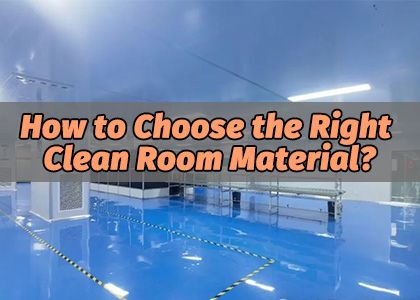
The selection of the right clean room material needs to consider a number of aspects, the following are some key points:
I. Material properties
Low particle emissions: Select materials that are not easy to produce particles, will not become a source of pollution, and have low VOCs emissions.
Easy to clean and corrosion resistant: the material should be resistant to chemical corrosion and easy to clean to avoid the production of particles or the release of harmful substances during long-term use.
Smooth and smooth: the surface of the material should be seamless to reduce the adsorption and retention of dust and microorganisms.
Other characteristics: The ground material should have wear-resistant and anti-slip characteristics; If static electricity is easily generated, select ESD materials.
II. Specific material recommendation
Wall and ceiling materials: color steel plate, stainless steel plate, polyvinyl chloride (PVC) plate, aluminum plate, etc., these materials have the advantages of smooth surface, not easy to accumulate dust, corrosion resistance, easy to clean and so on.
Floor material: epoxy self-leveling floor, PVC floor is preferred, they are seamless, not easy to accumulate dust, and wear-resistant, non-slip, easy to clean and maintain.
Door and window materials: Aluminum alloy materials with good sealing should be selected to ensure the air purification effect of the laboratory and prevent the entry of pollutants.
Other materials: such as purified ventilation pipes can be made of galvanized steel plate or sprayed thin steel plate, and flame retardant insulation board is used for insulation.
III. Construction and maintenance
Construction requirements: wall, floor and ceiling should be maintained after construction of good flatness; Special sealing materials are used for joint treatment; Special connectors shall be used for material joints.
Care and maintenance: Clean and maintain the clean room regularly to reduce the accumulation of harmful particles and ensure the normal operation and air quality of the clean room.

IV. Precautions
1. No dust production and no dust adsorption: Clean room materials must avoid producing dust particles or attracting dust and pollutants. Therefore, when choosing building materials, priority should be given to those with high smoothness and smoothness, such as specific plastics, metals or coating materials.
2. Durability and stability: Clean room building materials should have excellent flame retardant properties to ensure the safety of the overall facility. It is essential to choose materials that meet fire protection standards.
3. Easy cleaning and stability: Since the clean room needs to maintain a very high standard of hygiene, the materials selected should be easy to clean with disinfectants to facilitate regular cleaning and disinfection. For example, antibacterial and corrosion-resistant surface materials can be selected.
4. Seamless design: Materials are applied to build seamless or nearly seamless surfaces to reduce the chance of contaminants hiding. This can be achieved by using special resins, tiles or metal materials.
5. Fire performance: Taking into account the importance of production safety, clean room building materials should have excellent flame retardant performance to ensure the safety of the overall facility.
6. The ability to adjust humidity and temperature: the environmental control of the clean room is the key, and the selected materials should be able to adapt to changes in humidity and temperature within a certain range, helping to maintain a stable state of the clean room.
7. Anti-static: In order to avoid the adsorption of dust and potential risks of electrostatic discharge, materials that are easy to generate static electricity should be avoided, and materials with anti-static characteristics are more appropriate.
8. Air tightness: For the doors, Windows and partitions of the clean room, it should be ensured that their air tightness is good to maintain the pressure gradient of the room and prevent the penetration of pollutants.
9. Comply with industry standards: Materials should comply with relevant industry specifications and standards, such as GMP, FDA requirements, etc., to ensure its applicability in a specific field.
10. The professionalism and reputation of suppliers: choosing experienced and reputable suppliers can ensure the quality of materials and the stability of supply, and avoid various problems that may occur later.